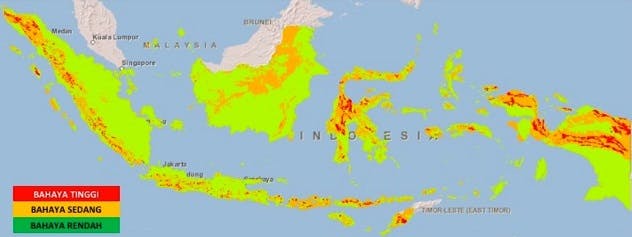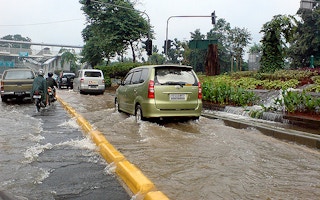Last year, an extended dry season brought on by El Nino set the stage for one of the worst natural disasters Indonesia has seen, the devastating forest and peatland fires that burned an area the size of Macedonia.
This year, an extra-wet dry season brought on by La Nina is bringing calamity in a different form: floods and landslides.
At least 64 people were killed this month in landslides and flash floods and thousands more were displaced, the nation’s disaster management chief, Sutopo Purwo Nugroho, said on Friday.
Central Java caught it the worst, with 59 dead in the province, including 43 casualties in Purworejo district, which has declared a state of emergency.
At least five more died in the Sangihe Islands in North Sulawesi.
Ninety-nine people have been killed by landslides this year, Nugroho said, and more than 2,000 had died or gone missing since 2005.
The landslides, he added, were expected to peak from December to March 2017.
The government has installed Landslide Early Warning Systems in parts of the country, but many of them are not working well, according to Nugroho.
Community and local government preparedness were also low, he said, based on surveys by the Indonesian Institute of Sciences (LIPI) and UNESCO.
“
Natural disasters will continue to increase if the carrying capacity of the environment is not taken into account.
Soeryo Adiwibowo, senior advisor, Environment and Forestry Ministry
He called for the government to raise the National Disaster Mitigation Agency’s budget.
“Ideally, 1 per cent of the budget would be earmarked for dealing with national disasters,” he said. “Now it’s .02-.07 per cent.”

A map of Indonesia shows at-risk areas for landslides in red. Image courtesy of the National Disaster Mitigation Agency.
Massive development on Java, the world’s most crowded island, has tended to neglect the environment, according to Soeryo Adiwibowo, a Bogor Agricultural Institute professor and senior Environment and Forestry Ministry advisor.
In the 19th century, Java’s forests spanned 10 million hectares, an area the size of South Korea. By 1989 they covered only 1 million hectares, and in 2005 they spanned 400,000 hectares.
Deforestation creates the condition for landslides because trees hold the soil in place.
“Natural disasters will continue to increase if the carrying capacity of the environment is not taken into account,” Adiwibowo said.
The area around Java’s South Coast Road was shaping up to be a new growth center, he added.
A 2008 study by Adiwibowo and colleagues, which found that Java was being dangerously overexploited, “did not get a good response from the government,” he said.
The professor said the cement industry should not continue in Java and asked the government to issue a negative investment list for the island to clamp down on natural resource extraction.
“China already made a negative investment list, including for the cement industry, so now they’re all flocking to Java.”
This story was published with permission from Mongabay.










